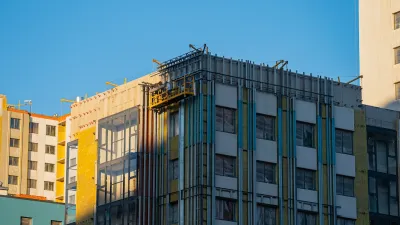The doubled incentive could be a ‘tipping point’ for innovative construction materials that were too expensive for most projects.

As part of its goal to reduce U.S. carbon emissions by 40 percent by 2030, the Inflation Reduction Act (IRA) expands tax credits for energy efficiency retrofits, reports Jack Rogers for Globe St. “Under the IRA, the maximum allowable benefit for the 179D Energy Efficient Buildings Tax Deduction will expand in 2023 from $1.88 per square foot to $5.00 per SF.”
As Rogers explains, “The 179D deduction has a tiered system of energy-use reductions that are required for the full deduction; it also allows fractional deductions for partial compliance. To be in full compliance, buildings have to reduce the energy and power cost of interior lighting, HVAC and hot-water systems by 50% or more.”
According to Jameson Hartman, VP at Real Estate Technology Ventures (RET), “This bill is likely a tipping point for envelope solutions—roof, floors, walls, etc.—utilizing new material improvements that were too costly before.” Hartman predicts that “We should see substantial growth of technologies and platforms that fall under the energy efficiency landscape, including investments in solutions that improve a building’s envelope, HVAC systems and interior lighting systems.”
FULL STORY: Inflation Reduction Act Doubles Tax Credits for Building Retrofits

Planetizen Federal Action Tracker
A weekly monitor of how Trump’s orders and actions are impacting planners and planning in America.

Maui's Vacation Rental Debate Turns Ugly
Verbal attacks, misinformation campaigns and fistfights plague a high-stakes debate to convert thousands of vacation rentals into long-term housing.

San Francisco Suspends Traffic Calming Amidst Record Deaths
Citing “a challenging fiscal landscape,” the city will cease the program on the heels of 42 traffic deaths, including 24 pedestrians.

Amtrak Rolls Out New Orleans to Alabama “Mardi Gras” Train
The new service will operate morning and evening departures between Mobile and New Orleans.

The Subversive Car-Free Guide to Trump's Great American Road Trip
Car-free ways to access Chicagoland’s best tourist attractions.

San Antonio and Austin are Fusing Into one Massive Megaregion
The region spanning the two central Texas cities is growing fast, posing challenges for local infrastructure and water supplies.
Urban Design for Planners 1: Software Tools
This six-course series explores essential urban design concepts using open source software and equips planners with the tools they need to participate fully in the urban design process.
Planning for Universal Design
Learn the tools for implementing Universal Design in planning regulations.
Heyer Gruel & Associates PA
JM Goldson LLC
Custer County Colorado
City of Camden Redevelopment Agency
City of Astoria
Transportation Research & Education Center (TREC) at Portland State University
Jefferson Parish Government
Camden Redevelopment Agency
City of Claremont





























